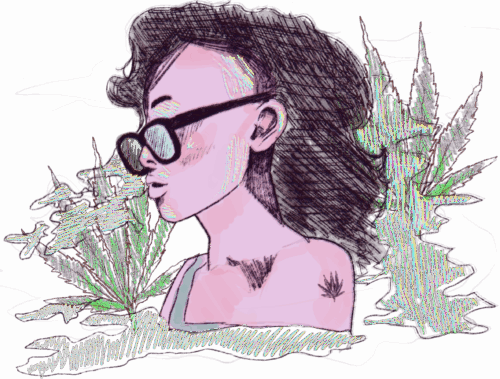She wore a Miu Miu headband and carried a pastel tote bag as she stepped out of the dispensary, clutching a few 5mg hybrid gummies and a pre-roll “for later.” I passed the storefront—blush-pink shelves, botanical product cards, a wall of tastefully labeled vapes—and thought: we didn’t decriminalize weed. We domesticated it.
Not repaired the lives it helped ruin. Just redesigned it.
The politics didn’t shift. The packaging did.
Weed used to mean opting out: slowness, stasis, failure. The stoner wasn’t edgy or interesting—he was a warning, a punchline, the guy in the corner you were told not to become. Cannabis culture was painted as a dead end and criminalized accordingly.
Now, weed is culture. It’s boxed, boutique-approved relaxation. No longer what dropouts do—it’s what wellness influencers post about. The same behaviors once used to profile, punish, or exclude are now folded into the rituals of self-care. It’s curated, not careless. Chic, not criminal.
The dispensary around the corner doesn’t look like it sells weed. It looks like it sells peace of mind. Soft lighting. Clean shelving. Succulents arranged like sculptures. Products sit on floating glass in pastel tins, labeled like adaptogenic teas. Nothing smells like smoke.
Weed has become just another lifestyle object—engineered to soothe, designed to blend in. Its aesthetic mirrors the branding of Ghia, Flamingo, and Glossier: earth tones, matte finishes, and UX-perfect gradients. What once aimed to disorient now promises alignment.
This shift isn’t just aesthetic. It’s ideological. Weed has been reengineered for the self-optimizing consumer: wellness without the woo, calm without chaos, rebellion without consequence.
The stoner is out. The microdoser is in.
Get high—but be productive. Stay soft—but stay functional. Rebrand the illicit as aspirational. Normalize the ritual. Monetize the vibe.
Even in the art world, weed has been rebranded. Once the stuff of outsider graffiti and psychedelic zines, it’s now gallery-safe. In Chelsea, you’ll find cannabis-themed installations with ambient playlists, QR codes, and sponsorships from boutique beverage brands. The weed isn’t meant to shock anymore. It’s meant to soothe. To sell.
It wasn’t always this polished. In the ’60s and ’70s, cannabis culture created a visual language that was loud, improvised, and joyously disruptive. Posters dripped with hallucination—melting skulls, vibrating fonts, cosmic smoke. The point wasn’t aesthetic harmony. The point was refusal.
That refusal didn’t vanish. It got mood-boarded. What once lived on the margins—illicit, unbranded, uninvited—has been flattened into a lifestyle. The weirdness got ironed out. The danger dialed down. What’s left is an image: cannabis as calm, curated self-expression. You can now buy the aesthetic of rebellion in a recyclable tin.
But weed didn’t just get softer. It got safer—but only for some. Safer for the ones less likely to be stopped, searched, or sentenced.
On campus, the redesign is easy to spot. Some students light up outside dorms like it’s an herbal supplement—just another step in their bedtime routine. Others instinctively walk further. Cross the street. Smoke only off-campus.
A classmate once told me they’d never smoke near the Yard—not because of the weed, but because of how they’d be seen. Even now, Black Americans are over three times more likely to be arrested for weed than white Americans—despite using it at similar rates. Same act, different consequences. The smell of weed doesn’t cling to everyone the same way.
That’s the real rebrand. Not just the fonts and colors, but the bodies, allowed to relax.
Weed has become a lifestyle product for the people most protected from its past. The ones who can post their gummies in an Instagram carousel. The ones who never had to worry about the smell trailing behind them. The ones for whom “stoner” now means chill, not criminal.
But if weed is now all soft light and smooth lines, what happens to the parts that don’t fit the vibe? The risks that aren’t brandable? The side effects that don’t come with an iced matcha latte?
Behind the oat milk colorways and biodegradable packaging, there’s another reality: three in ten users will develop cannabis use disorder. Teenagers—whose brains are still developing—are especially at risk. Long-term use has been linked to psychosis. Memory loss. Mood disruption. Coordination issues. None of that gets a tote bag.
And this isn’t the weed of decades past. Today’s products are hyper-engineered: crossbred strains, concentrated oils, delayed-onset edibles that hit hours later and linger in your system. Marketed as serenity—but often experienced as precision-delivered chaos. Dosed. Disguised. Branded as balance.
What’s being sold isn’t just weed—it’s a curated illusion of control.
Weed didn’t climb the cultural ladder—the ladder just got redecorated. What once marked you as a problem now makes you marketable. Tie a ribbon around it, lower the dosage, soften the palette—and suddenly the stigma becomes a lifestyle.
As cannabis is folded into the rhythms of consumer life, its history, its harms, and its heaviness are repackaged as aesthetic. Even the high becomes part of the productivity cycle—a brief, optimized detour in the name of self-care.
So what does it mean that weed is now wrapped in soft pinks and sustainable packaging?
Maybe it means rebellion didn’t disappear. It just got redesigned. Smaller. Softer. Market-safe. Five milligrams at a time.
Luke Wagner ’26 (lukewagner@college.harvard.edu) is the Vice President of the Independent.

